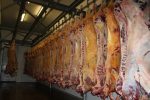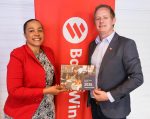Elevate Uranium is going gangbusters exploring and expanding resources on its projects in Namibia, with five drill rigs currently operating across the Koppies, Hirabeb and Capri projects.
Koppies is one of the shallowest uranium resources globally, with approximately 95% of the total mineral resource being within 18.5m of the surface, and 50% of the resource within 7m of the surface.
These parameters imply a potential low strip ratio and low-cost mining operation at Koppies, which would be beneficial to the overall economics of any future operation.
The current drilling programs are focused on expansion and increasing the level of certainty around the company’s high-priority projects at Koppies, Hirabeb, and Capri.
Three drill rigs are working on an extensive infill program at Koppies to convert the 134.6Mt at 195ppm U3O8, or 57.8Mlb of contained eU3O8 inferred resource to indicated category, with a resource update expected later in the year.
The Hirabeb and Capri projects have one rig each, with the rig at Hirabeb working through a phased greenfields exploration and infill drilling program targeting a maiden resource estimate later this year.
A two-phase greenfields exploration and infill drilling program is underway at Capri, targeting the known mineralised area to refine the mineralisation outline.
“Five reverse circulation drill rigs are progressing well on the exploration and infill drilling programs, with the aim of increasing the confidence level of the Koppies resource and adding pounds at the other projects,” Elevate Uranium managing director Murray Hill said.
“Three of those drill rigs are operating at Koppies, converting the existing inferred resource to JORC indicated resource.
“The other two drill rigs are focusing on our Hirabeb and Capri projects to further delineate mineralisation identified from previous broad spaced exploration drilling programs.
“We have drilled 1979 holes for a total of 52,698 metres on the programs on these three projects alone this calendar year, in addition to holes drilled at Koppies prior to the resource update in April.
“At Hirabeb, we achieved some excellent results, including 15.5m at 599ppm U3O8 and 12m at 451ppm U3O8, 7.5m at 616ppm U3O8 and 4m at 1198ppm U3O8.”
In addition to maintaining prospective uranium acreage and resources within Namibia, EL8 also retains a potentially ground-breaking technology that could radically improve the commerciality of calcrete-hosted uranium deposits.
The U-pgradeTM process has the capacity to lower the operating cost-base specifically for shallow secondary uranium deposits, thereby improving operating margins, profitability and commerciality.
The beneficiation process, developed on ore from the 61Mlb Marenica project (also in Namibia), rejects greater than 95% of the mass of uranium ore through removal of non-uranium bearing minerals.
Six tonnes of ore samples collected from Koppies are now in transit to Perth for a metallurgical testwork program utilising the process, with results expected to inform the design of an U-pgradeTM pilot plant program on Koppies ore, planned for 2025.
“I’m excited about commencing the U-pgradeTM testwork program on Koppies ore samples and planning for the pilot plant operation,” Hill said.
In addition, the company’s JV partner has commenced a 10,000m drill program at the Bigrlyi Uranium Project in the NT, in which EL8 holds a 20.82% joint venture interest.
“In the Northern Territory of Australia, our joint venture partner at the Bigrlyi uranium project has commenced a drilling program aimed at growing the uranium resource by targeting extensions of known mineralisation in high-grade areas, and we look forward to the progress of this three-month program,” Hill said.
The company plans to maintain the current level of activity and execute on its growth and exploration plans throughout the remainder of 2024.










